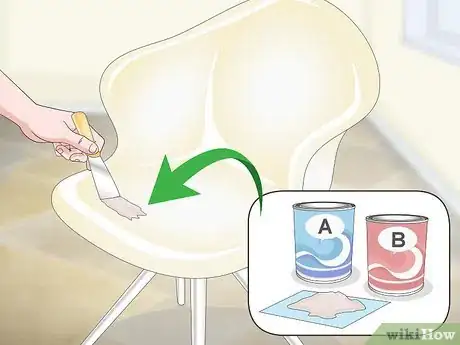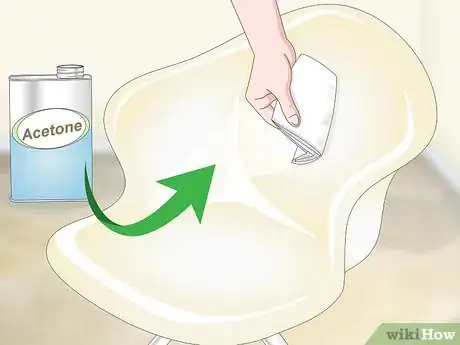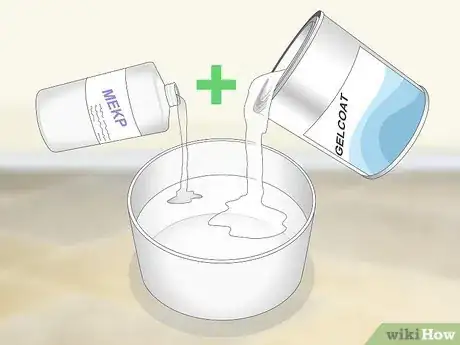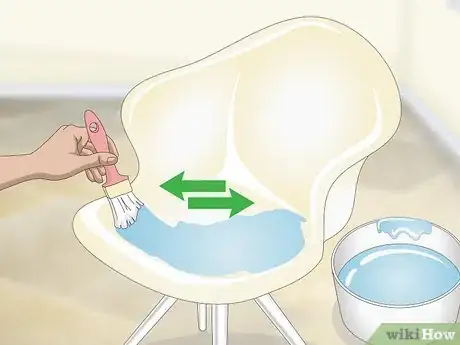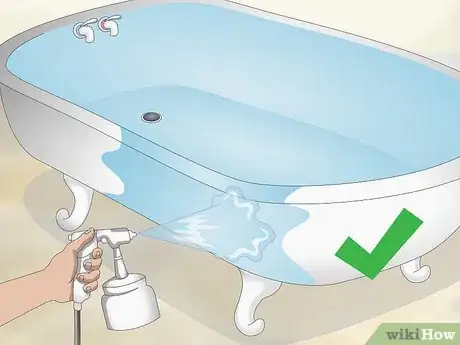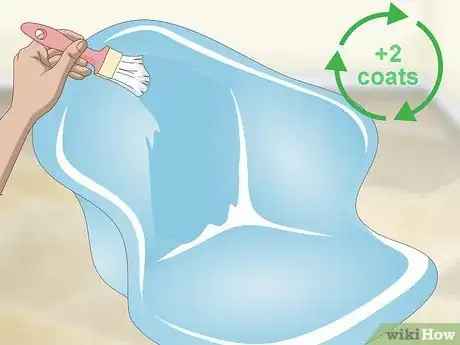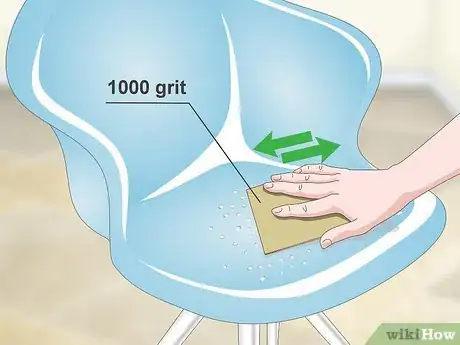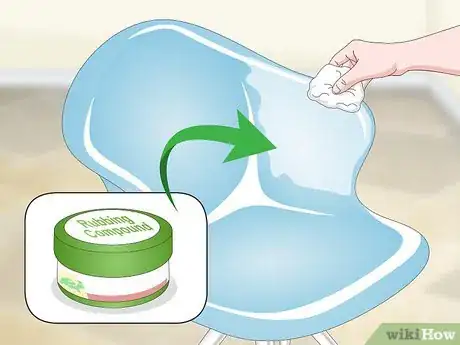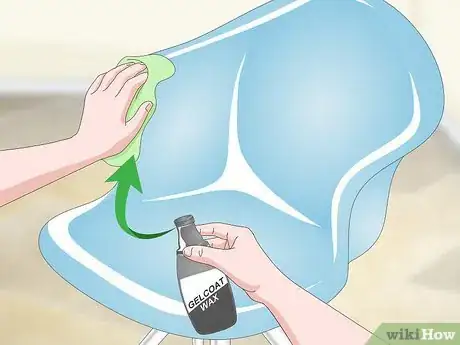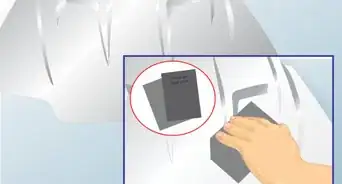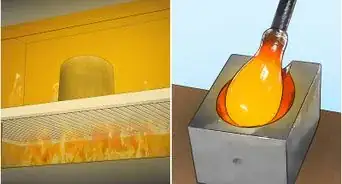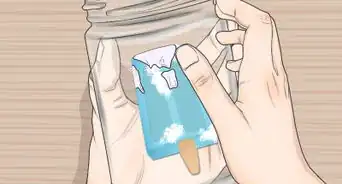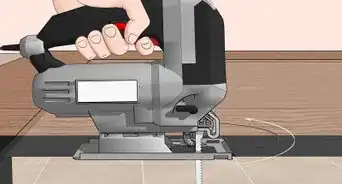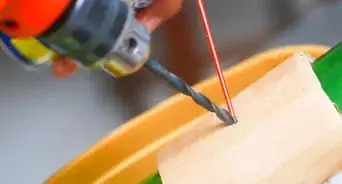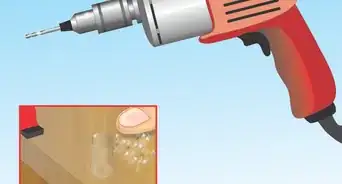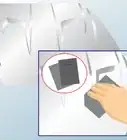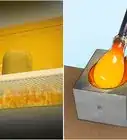This article was co-authored by wikiHow staff writer, Kyle Hall. Kyle Hall works on the content team at wikiHow. He helps manage our team of editors and creates content for a variety of wikiHow projects. Kyle continually looks for new ways to improve the content at wikiHow and make it more helpful and enjoyable for readers. He graduated from Eckerd College in 2015, where he majored in Political Science.
wikiHow marks an article as reader-approved once it receives enough positive feedback. In this case, 96% of readers who voted found the article helpful, earning it our reader-approved status.
This article has been viewed 428,534 times.
Learn more...
Gelcoat is a liquid that hardens to form a thick layer that's used to protect fiberglass and give it a shiny, smooth finish. Applying gelcoat to fiberglass is simple if you have the right tools and take care to mix your gelcoat properly.
Steps
Preparation
-
1Fill in any cracks or gouges in the fiberglass with polyester filler, marine grade. Epoxy filler, although a great product is not suitable for a gel-cote top coat. Polyester gel-cotes will not chemically bond to epoxy. You’ll want to take care of any damage on the fiberglass first so you have a smooth surface to apply the gelcoat to. To fill in damaged areas, start by sanding them with coarse 36 grit sandpaper to remove any debris. Then, fill in the damaged areas with the polyester filler using a plastic spreader.[1]
- Let the polyester filler cure until material is firm and tack free, about 10 minutes. Sand it down with 80 grit sandpaper until it’s flush with the surface of the fiberglass.
-
2Clean the fiberglass surface with ajax or comet and water. It’s important that the fiberglass is clean before you gelcoat over it. If there’s any dirt or dust on the fiberglass, it will get trapped under the gelcoat. Go over the fiberglass with a soapy rag and then wipe it down with a clean rag to remove any leftover suds.[2]
- If you’re cleaning a large fiberglass surface, like the hull of a boat, use a power washer to make the process easier and faster, be very careful, as a power washer can actually cut fiberglass and blow chunks right off surface.
Advertisement -
3Wipe the fiberglass down with acetone to remove grease and wax. This step is especially important if you’re gel-coating old fiberglass that already has a coating on it. Removing any grease or wax on the fiberglass will help the gelcoat adhere better to the material’s surface. Once you’ve gone over the whole surface with a rag soaked in acetone, and immediately removing it while still wet with a second dry rag.[3]
Application
-
1Combine gelcoat and methyl ethyl ketone peroxide in a bucket. Methyl ethyl ketone peroxide (MEKP) is a catalyst used to make gelcoat start to harden. You’ll need to buy a container of MEKP separately if it doesn’t come with your gelcoat. Refer to the manufacturer’s instructions on the side of the gelcoat can to see how much MEKP you need to mix with the gelcoat.[4]
- The amount of MEKP you’ll need to use will depend on how much gelcoat you’re using and what brand it is. Make sure you follow the manufacturer’s instructions so the gelcoat isn’t the wrong consistency.
-
2Add gelcoat color pigments if you want your gelcoat to be colored. If you want the gelcoat to be a different color than white, you'll need to add color pigments. Buy gelcoat color pigments that match the color you’re looking for and follow the manufacturer’s instructions to mix the pigments into the gelcoat.
-
3Apply the gelcoat using a brush if you’re covering a small area. To apply the gelcoat with a brush, dip the brush in the gelcoat so there’s a liberal amount of gelcoat on it. Brush the gelcoat onto the fiberglass using short vertical strokes. Avoid spreading the gelcoat too thin or you’ll get stroke marks. You want there to be a thick, even layer of gelcoat on the fiberglass.[5]
- When you’re finished, you shouldn’t be able to see any of the fiberglass underneath the gelcoat.
-
4Apply the gelcoat with a gelcoat spray gun if it’s a large fiberglass surface. A gelcoat spray gun will make it easier to get an even coverage on a large fiberglass surface. To use a gelcoat spray gun, fill the plastic container on the gun with your gelcoat. Then, attach the cord on the gun to an air supply source, like an air compressor. Hold the spray gun about 1 foot (0.30 m) away from the fiberglass and spray the gelcoat onto it in short, even strokes.[6]
- You can buy a gelcoat spray gun online or at your local paint store.
-
5Let the first coat of gelcoat dry for 4 hours and then check on it. The first coat should feel tacky when you touch it. Try pressing into the gelcoat with your fingernail — if it doesn’t leave an impression, the gelcoat is dry enough. If your fingernail does leave an impression, let the gelcoat dry for a couple more hours.
-
6Apply 2 more coats of gelcoat to the fiberglass. Three coats should be enough, but you can do more coats if you’re not satisfied with the final result. Let the second coat dry for 4 hours like you did with the first coat. For the final cote add sanding aid.. A mixture of styrene and gulf wax, to the gel-cote and add MEKP as before. This may be purchased at the same place you bought the gel-cote. It is important to note that gelcoat is air inhibited, meaning that it will not fully cure in the presence of oxygen. The wax migrates to the surface of the final coat and creates a barrier to allow the gel to cure.
Finishing
-
1Sand the surface of the fiberglass with 1,000 grit sandpaper. Sanding the fiberglass will help smooth out any rough spots in the gelcoat. If you’re sanding a large fiberglass surface, like the hull of a boat, use a random orbit sander to speed up the process. When you’re done sanding, wipe away any dust with a dry rag.[7]
-
2Apply rubbing compound to the fiberglass with a cloth. Rubbing compound contains small particles in it that help buff out a surface and make it smoother and shinier. Buff the compound into the fiberglass surface in a circular motion until the compound fades. If you’re working with a large section of fiberglass, use an electric buffer to apply the rubbing compound.[8]
-
3Apply a wax over the gelcoat to protect it. Wax will also make the gelcoat shinier and more reflective. Use a wax designed specifically for gelcoat or fiberglass. Use a cloth to apply enough wax to the fiberglass that there's a thin, visible layer over the entire surface. When the wax dries, buff it off with another cloth.[9]
Community Q&A
-
QuestionCan I apply a gel coat with a brush?
 Community AnswerYou can apply gel coat with a brush if you are building a fiberglass project in a mold. First you would apply a release agent to the mold, then brush on the gel coat. You can wait 24 hours or continue building your project immediately, the gel coat will not cure until it is sealed in the mold by your fiberglass layers. Third, apply fiber glass layers.
Community AnswerYou can apply gel coat with a brush if you are building a fiberglass project in a mold. First you would apply a release agent to the mold, then brush on the gel coat. You can wait 24 hours or continue building your project immediately, the gel coat will not cure until it is sealed in the mold by your fiberglass layers. Third, apply fiber glass layers. -
QuestionHow do I know if my boat needs gelcoat?
 Community AnswerInspect the boat's finish to see if it is still shiny or has imperfections. If the finish is dull in some places and shiny in others, it is probably time to apply gelcoat.
Community AnswerInspect the boat's finish to see if it is still shiny or has imperfections. If the finish is dull in some places and shiny in others, it is probably time to apply gelcoat. -
QuestionWhy is gelcoat sticky after applying to fiberglass?
 Community AnswerYou can get rid of this stickiness with one more coat of wax. Gel Coat must cure without presence of air; it's often done in a mold so it cures between the object fiberglass and the mold. Two additives will help with a desired final finish. The important one here is wax. Wax in the Gel Coat rises to the surface when it is sprayed, rolled, or brushed, creating a film and barrier that enables the curing to happen. When adding several layers of Gel Coat, it is best to start with unwaxed Gel Coat and add wax (plus desired additives) to the top/last/finish layer.
Community AnswerYou can get rid of this stickiness with one more coat of wax. Gel Coat must cure without presence of air; it's often done in a mold so it cures between the object fiberglass and the mold. Two additives will help with a desired final finish. The important one here is wax. Wax in the Gel Coat rises to the surface when it is sprayed, rolled, or brushed, creating a film and barrier that enables the curing to happen. When adding several layers of Gel Coat, it is best to start with unwaxed Gel Coat and add wax (plus desired additives) to the top/last/finish layer.
Things You’ll Need
- polyester marine grade filler
- Rags
- gel cote
- pigment
- sanding aid
- Soap
- Acetone
- Methyl ethyl ketone peroxide (MEKP)
- Paintbrush
- Gelcoat spray gun
- 1,000-grit sandpaper
- Rubbing compound
- Wax
References
- ↑ https://www.youtube.com/watch?v=cH5vMiNBCsU&feature=youtu.be&t=125
- ↑ https://www.powerandmotoryacht.com/maintenance/how-to-maintain-the-gelcoat-on-your-boat
- ↑ https://www.boatingmag.com/how-to-repair-damaged-gelcoat#page-11
- ↑ https://www.boatingmag.com/how-to-repair-damaged-gelcoat#page-9
- ↑ https://www.youtube.com/watch?v=_itHDix3hPE&feature=youtu.be&t=12
- ↑ https://www.youtube.com/watch?v=kSPIrow89Bc&feature=youtu.be&t=605
- ↑ https://www.boatingmag.com/how-to-repair-damaged-gelcoat#page-11
- ↑ https://www.boatingmag.com/how-to-repair-damaged-gelcoat#page-11
- ↑ https://www.boatingmag.com/how-to-repair-damaged-gelcoat#page-11
About This Article
Before you gelcoat fiberglass, fill in any cracks or gouges with a polyester filler and then sand the damaged areas down with 80-grit sandpaper. Clean the fiberglass with soap and water and wipe it down with a rag soaked in acetone, and immediately removing it with a clean dry rag. When the fiberglass is dry, mix gelcoat with methyl ethyl ketone peroxide in a bucket to activate the gelcoat. For small sections of fiberglass, apply the gelcoat with a brush. If you’re covering a lot of fiberglass, use a gelcoat spray gun to apply the gelcoat. For tips on how to sand and wax the gelcoat once it dries, keep reading!
